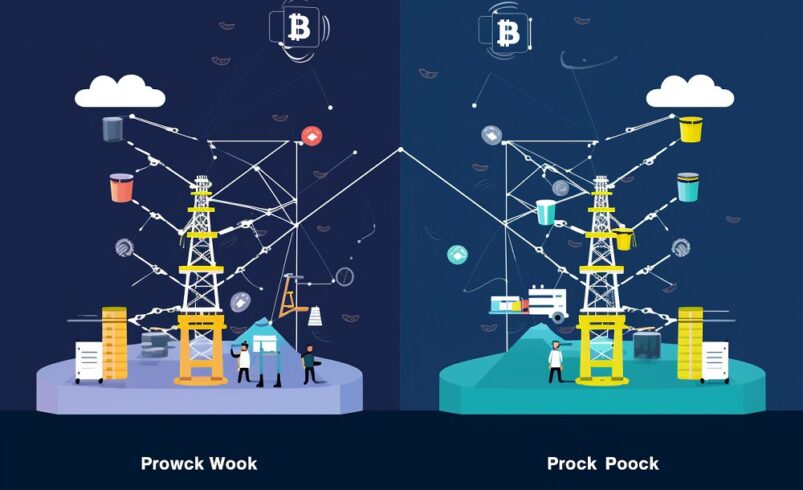Proof-Of-Work Vs. Proof-Of-Stake: A Beginner’s Guide To Understanding Their Differences

Table of Contents
Two prominent consensus mechanisms in blockchain technology reign supreme – Proof-of-Work (PoW) and Proof-of-Stake (PoS). These mechanisms are pivotal in maintaining decentralized networks’ integrity, security, and functionality.
This guide explores PoW and PoS, clearly distinguishing between the two.
Understanding Proof-of-Work (PoW) Mechanics
Initially conceptualized as a solution against spam and service attacks, PoW gained prominence through Satoshi Nakamoto’s design for Bitcoin. PoW relies on miners solving complex mathematical puzzles through computational power, resulting in the validation of new blocks on the blockchain.
This process, termed “mining,” secures the network and maintains a chronological ledger of transactions. The block’s authenticity is validated through a cryptographic link, and successful miners are rewarded with freshly minted coins.
Pros of PoW
Security: Provides a robust defense against fraudulent activities and double-spending.
Game Theory Dynamics: Encourages rational decision-making among miners, bolstering network stability.
Cons of PoW
Energy Consumption: Demands substantial energy usage and incurs high operational costs.
Resource Intensiveness: Requires expensive equipment and leads to heightened transaction fees during network congestion.
Understanding Proof-of-Stake (PoS) Dynamics
Proof-of-Stake is an energy-efficient alternative to PoW. Here, validators secure the network by holding and “staking” a certain quantity of native cryptocurrency tokens.
The probability of validating a block is directly proportional to the tokens staked, and malicious actors risk losing the stake. Unlike PoW, PoS doesn’t involve mining; instead, it fosters scalability and faster transaction approvals.
Pros of PoS
Energy Efficiency: Reduces the environmental impact by eliminating resource-heavy mining.
Scalability: Enables faster transaction processing and heightened network efficiency.
Cons of PoS
Dominance by Token Holders: Potential centralization risk due to the concentration of tokens among early adopters.
Comparison Between PoW And PoS
PoW and PoS are foundational pillars in the blockchain sector, each offering distinct methodologies and benefits.
Validation Mechanism: In PoW, computational power validates blocks via puzzle-solving. However, PoS relies on staked tokens for block validation, skipping resource-heavy mining.
Energy Efficiency: PoW’s computational demands drive high energy use. PoS consumes significantly less energy and promotes eco-friendly practices.
Network Scalability: While PoW’s mining limits scalability, PoS enables faster transactions, enhancing network efficiency and scalability.
Security Measures: PoW ensures strong security, thwarting fraud like double-spending. PoS faces centralization worries from dominant token holders.
When To Use PoW Or PoS
The choice between PoW and PoS hinges on specific network requirements. PoW is ideal for establishing trust, security, and immutability in a network, particularly in preventing fraud and maintaining a distributed clock.
In contrast, PoS works best for networks needing higher transaction speeds, low energy consumption, and better scalability and prioritizes stakeholder validation. Moreover, the blockchain landscape continuously evolves, prompting the emergence of hybrid and innovative consensus mechanisms like Proof-of-Space (Chia project).
These mechanisms aim to address the limitations of both PoW and PoS. Understanding the minute differences and suitability of each mechanism aids in navigating the diverse needs and challenges encountered in decentralized networks, laying the groundwork for tailored consensus solutions in various blockchain ecosystems.
Real-World Applications Of PoW And PoS
Proof-of-Work (PoW) and Proof-of-Stake (PoS) mechanisms play pivotal roles in various real-world applications within the blockchain ecosystem.
PoW Use Cases
Cryptocurrency Mining: PoW is prominently used in Bitcoin and numerous other cryptocurrencies to validate transactions through mining, ensuring secure and immutable transaction histories.
Supply Chain Management: In industries like logistics and food, PoW-based blockchains authenticate product provenance, enhancing transparency and trust among stakeholders.
Digital Asset Ownership: Platforms employing PoW facilitate secure token issuance and trading, ensuring ownership and authenticity of digital assets.
PoS Real-World Scenarios
Decentralized Finance (DeFi): PoS mechanisms are widely adopted in DeFi projects like Ethereum 2.0, enhancing transaction speed and reducing energy consumption.
Blockchain Governance: PoS-based blockchains enable stakeholders to participate in decision-making, promoting a more democratic governance model.
Energy-Efficient Networks: Various blockchain projects utilize PoS for energy-efficient operations, minimizing carbon footprints, and promoting eco-friendly practices.
Future Prospects And Considerations
The future of PoW and PoS holds several prospects and considerations. These include:
Hybrid Solutions and Innovations
Recently, the blockchain industry witnessed exploration into hybrid consensus models combining the strengths of PoW and PoS. This development aims to optimize security, scalability, and sustainability.
Continued innovation in consensus mechanisms, such as proof-of-space-time and delegated proof-of-stake, seeks to address existing limitations while pushing the boundaries of efficiency and security.
Embracing Diversity in Consensus
Networks increasingly opt for consensus mechanisms tailored to their specific requirements. This leads to a diversification of approaches beyond PoW and PoS.
The adaptability of blockchain networks in adopting suitable consensus mechanisms marks a pivotal step toward their widespread scalability and sustainability.
Final Thoughts
As the blockchain ecosystem continues to evolve, the coexistence of various consensus mechanisms and the exploration of novel models will pave the way for a more inclusive, resilient, and sustainable future for decentralized networks. Nevertheless, understanding the dynamic nature of consensus mechanisms allows stakeholders to navigate this evolving terrain and shape the future of blockchain technology.
Time Crypto Market offers content visibility for dozens of crypto enterprises, and you can be a part of our network! Reach out to us on our telegram chat for inquiries. The nature of cryptocurrencies is highly unpredictable; always perform your due diligence before any investment. Several articles on our site come from guest contributors or are commissioned pieces, not originating from Time Crypto Market's in-house writers. The perspectives shared in these articles might not necessarily align with those of Time Crypto Market. We do not assume responsibility for the veracity, caliber, promotions, offerings, or any other elements presented on our platform. Consult our comprehensive terms of service and disclaimer for more details.








